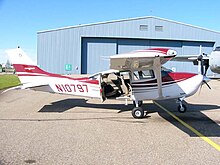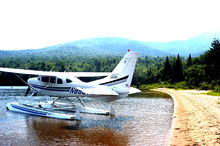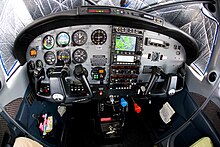Cessna 206
| Cessna 205/206 | |
|---|---|
 Cessna 206 Stationair |
|
| Type: | Light aircraft |
| Design country: | |
| Manufacturer: | |
| First flight: |
1962 |
| Commissioning: |
1962 |
| Number of pieces: |
Over 7,800 |
The Cessna models 205 and 206 , also known as the "Super Skywagon", "Super Skylane" and "Stationair", are a family of six - seat, single-engine, light aircraft with fixed landing gear that were designed for commercial use, but which are themselves also developed into a popular series for private pilots. It was developed as a modification of the successful Cessna 210 , which, unlike the 206 family, has a retractable landing gear.
The combination of a reliable, powerful engine (191–228 kW / 260–310 hp), robust construction and large cabin with easy access through large doors quickly established the Cessna 206 as a successful bush plane. In this function, it is often equipped with floats or skis for use on the water or snow and ice. Other commercial areas of application are aerial photography and the dropping of parachutists.
Production began in 1962 and ran until 1986. In 1998, production was restarted with slight modifications. In total, more than 7800 Cessna 205 and 206 were built. From 1968 to 1985 a total of 788 units of the extended version Cessna 207 were built under the name “Skywagon”, later “Stationair”.
Development and versions

Cessna 205
The six-seat Cessna 205 was introduced at the end of 1962 as the first model in the 206 family. It was essentially a Cessna 210 with a fixed landing gear and some changes to the pilot and passenger doors. Although the landing gear was no longer retractable, the engine cover of the Cessna 210 with its typical bulge to accommodate the nose wheel was retained. This detail should only disappear with the appearance of the 206. The official model name was "Model 210-5".
The 205 was powered by a Continental IO-470-S six-cylinder with 191 kW (260 hp).
Of the 205, 576 copies were made (only in 1963 and 1964). This was followed by the replacement by the 206.
Cessna 206
The 206 was presented in the 1964 model year and built until 1986. In 1998 production was resumed and continues today (as of 2020). The most important change is likely to have been the switch to Lycoming engines, which enabled considerably longer inspection intervals within the maximum 2000 hours of operation and thus helped to significantly reduce the operating costs of the 206. The 206 was manufactured in many variants, the most famous of which were the U206 and the P206. They have been certified according to the American CAR3 standards, 206H according to ' FAR Part 23'. Cessna offered three different equipment options for the cabin, ranging from elegant to robust.
Between 1964 and 2004, 6581 206s were manufactured.
Cessna U206
The U206, introduced in 1964, was powered by a 210 kW (285 PS) Continental IO-520-A. The 'U' stands for 'utility'. The U206 received a pilot's door on the left and a large two-part door on the right, which enabled access to the rear seats and easy loading of bulky goods.
For use at higher altitudes, the TU206 was introduced, which was equipped with a turbo-charged Continental TSIO-520-C engine with 210 kW (285 PS). After 1967 the TU206 was equipped with a TSIO-520-F with 221 kW (300 PS) takeoff power. This additional power achieved through higher speed could be maintained for a maximum of five minutes, the maximum continuous power was also 210 kW. In connection with the large propeller diameter , the increase in speed could hardly be converted into more power, as the propeller tips were already turning in the supersonic range. The result was a barely perceptible increase in performance combined with an unpleasant noise development.
Between 1964 and 1969, the U206 was also known as the "Super Skywagon". From 1970 the name changed to "Stationair", based on "Station Wagon of the Air" (for example, "Kombi der Lüfte"), which describes the capabilities of the model quite well.
The U206 was manufactured in different versions from U206 to U206G.
In 1977 the U206 received a Continental IO-520-F with 221 kW (300 PS) continuous output (which was already achieved at lower speeds than the TSIO-520-F version of the engine) and which now actually has the output made. The TU206 turbo variant now received a TSIO 520 M engine with 228 kW (310 hp).
Cessna P206
The P206 was launched in 1965, with the 'P' standing for 'People'. The cabin doors here had the same arrangement as on the Cessna 210.
The P206 was produced between 1965 and 1970 and was powered by a Continental IO-520-A with 210 kW (285 PS). There was also a turbo version of the P206 (TP206), which was powered by a Continental TSIO-520-A with 210 kW.
Of the P206, 647 were produced as Super Skylane . This could give the impression that this is a variant of the Cessna 182 Skylane , which is not the case. The P206 was built in the variants P206 to P206E.
Cessna 206H
After production resumed in 1998 after a twelve-year hiatus, the revised Cessna 206H appeared. It is very similar to the U206 and is marketed as Stationair .
The 206H is now powered by a Lycoming IO-540-AC1A with 221 kW (300 PS), the turbo version by a Lycoming TSIO-540-AJ1A with 228 kW (310 PS).
Although the Cessna 206H is registered as a six-seater in the USA, for safety reasons it can only accommodate a maximum of five people in Canada. The reason for this is that the rear cabin door cannot be opened or can only be opened with a very cumbersome procedure when the landing flaps are extended.
Both the 206H and the T206H will still be produced in 2008. By the end of 2004, 221 units of the 206H and 505 units of the T206H had been produced. At the end of 2014, Cessna only offered the Turbo Stationair.
Cessna saw no market for a new edition of the P206.
Cessna 207
The Cessna 207 was developed from the six-seater Cessna 206 to have seven seats (later eight). Overall, the fuselage of the Cessna 207 was lengthened by around 114 cm compared to the 206. The handling of the machine was made more difficult in terms of turning radius and landing technique.
The 207 was introduced in model year 1969 and equipped with a Continental IO-520-F with 221 kW (300 PS); the turbo version received the same engine as the TU206.
Initially, the 207 was marketed under the name Skywagon . In 1978 the name was changed to Stationair 7 and in 1980 - after approval for eight seats - finally to Stationair 8 . A total of 788 Cessna 207 were made. The 207 was often used by air taxi companies on short-haul routes where the entire seating capacity could be used. Only a few Cessna 207 came into private hands.
operator
Military operator
-
 Argentina
Argentina
-
 Bolivia
Bolivia
-
 Chile
Chile
-
 Costa Rica
Costa Rica
-
 Djibouti
Djibouti
-
 Guyana
Guyana
-
 India
India
-
 Israel
Israel
-
 Mexico
Mexico
-
 Malaysia
Malaysia
-
 Paraguay
Paraguay
-
 Peru
Peru
-
 Philippines
Philippines
-
 Uruguay
Uruguay
-
 Venezuela
Venezuela
See also
literature
- Rod Simpson: The General Aviation Handbook. Midland Publishing 2005, ISBN 1-85780-222-5 .
- John WR Taylor: Jane's All The World's Aircraft, 1971-72. Jane's Yearbooks, London 1972.
Web links
- Cessna website Turbo Stationair
- EASA-TCDS-A.053 (PDF; 677 kB) - Type certification of the Cessna 206
- Cessna Pilots Association club of 205, 206, and 207 pilots
- Globalsecurity.org Cessna-206 military version website
- Technical data of the Cessna 206H
Individual evidence
- ↑ a b c d e f g h i j k l Aircraft Bluebook Spring 2006 Edition Penton Media, Overland Park, KS USA
- ^ Cessna website, Single Engine Aircraft, Turbo Stationair; accessed on March 19, 2020.
- ↑ Jane's 1971, p. 280
- ↑ Simpson 2005, pp. 86-87.





